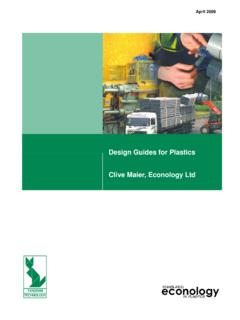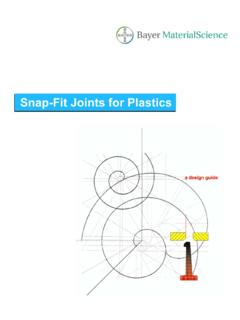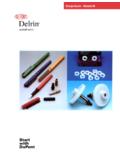Transcription of Philosophy of Troubleshooting Injection Molding Problems
1 Injection 1 plastics ENGINEERING COMPANY SHEBOYGAN, WISCONSIN 53082-0758 3518 LAKESHORE ROAD POST OFFICE BOX 758 PHONE 920 - 458 - 2121 F A X 920 - 458 - 1923 Philosophy of Troubleshooting Injection Molding Problems There is no "cure-all" for eliminating Molding Problems . Every mold is distinctive and has its own peculiarities, even molds which are exact duplicates. The same holds true for Molding presses. Therefore, what works for one mold or press may not work for another. Problems can differ with conditions such as the shop climate, material or equipment resulting in numerous variables, many of which are not obvious and are difficult to identify.
2 The Troubleshooting suggestions that follow have been used to successfully resolve the stated problem. However, due to the reasons mentioned above, several of them may seem to be contradictory. The most important thing to remember is make a reasonable adjustment and carefully observe the results. Document the change and keep track of the response by comparing parts from before and after the adjustment, to determine if the effect is favorable. This will lead to other changes that should eventually produce a solution to the problem. Thermoset materials cure as a result of a chemical reaction.
3 Temperature has a major role in the speed of the reaction and to a lesser degree so do pressure and time. Therefore all three items need to be verified before Troubleshooting any Molding problem. For Injection Molding , this means there are several items on the mold and press that should be checked before Troubleshooting any Molding problem. If Problems are found they should be corrected and the parts re-evaluated before proceeding. Mold - Check the actual mold temperature and its uniformity across the entire mold face and compare with what the temperature was the last time this mold was run in this press.
4 They should be the same or very close to it. If not, try to determine why there are differences before starting to mold. Press - Check actual settings for Injection pressure, back pressure, holding pressure, Injection speed, Injection time, screw speed and return time with the settings used the last time this mold was run in this press. They should be the same or very close to it. If not, try to determine why there are differences before starting to mold. Injection 2 Injection Processing Problems Please NOTE the following: Increased cycle time should not be used as a solution for a Molding problem, except as the very last resort to maintain the integrity of the molded parts.
5 Various processing changes are suggested as possible solutions for the different Problems encountered during the Molding of thermoset parts. In general, these changes should not exceed the recommended ranges presented in the previous sections on Injection startup procedures. This Troubleshooting guide lists the processing Problems in alphabetical order. For each problem, the possible solutions are listed in the order of the most frequent to the least frequent solution for that problem. Change only one processing variable at a time. Allow the press to cycle at a minimum of cycles and then thoroughly evaluate results before changing another processing variable.
6 Please keep in mind, that in order to resolve any given processing problem, a combination of the possible solutions may need to be applied. Plenco s Technical Service Group is available to assist you in Troubleshooting processing Problems . BALL & SOCKET - An internal circular failure pattern observed on Injection molded parts after breaking of the thickest cross-sectional area. One surface will resemble a ball and the other surface will resemble a socket. The texture and color of the socket area will differ from that of the ball. POSSIBLE SOLUTIONS 1. Decrease Injection speed.
7 2. Increase Injection and holding pressures. 3. Decrease mold temperature. 4. Increase the size of the gate and if possible relocate it. Injection 3 BULGE OPPOSITE INSERT - Bulges that appear on the side opposite and directly over molded-in inserts. POSSIBLE SOLUTIONS 1. Heat inserts to mold temperature before using. 2. Use a reduced size insert. 3. Increase mold temperature. 4. Increase stock temperature by increasing back pressure and/or barrel temperature. CURE BLISTER - Area of gas entrapment (blister) caused by not completely curing the part before removing it from the mold.
8 This generally shows up as a bulge on opposite sides of the thickest cross-sectional area of the part. When broken open, there will be a large void in the center of the bulge. POSSIBLE SOLUTIONS 1. Increase stock temperature by increasing back pressure and/or barrel temperature. 2. Increase mold temperature. 3. Increase cure time. 4. Decrease Injection speed. DULL APPEARANCE - The surface of the part has a hazy or satiny appearance instead of a glossy appearance. NOTE: Make sure part is completely filled out and mold is not stained. POSSIBLE SOLUTIONS 1. Increase mold temperature.
9 2. Increase stock temperature by increasing back pressure and/or barrel temperature. 3. Check condition of mold plating and re-plate if necessary. Polish and re-plate the mold. 4. Polish the mold. Injection 4 FLASH (EXCESSIVE) - Parts where the flash is thicker than mm ( ) or with flash extending out into the land areas are considered to have excessive flash. POSSIBLE SOLUTIONS 1. Decrease shot size. 2. Decrease Injection and holding pressures. 3. Increase stock temperature by increasing back pressure and/or barrel temperature. 4. Increase mold temperature. 5. Check parting line for wear or damage and correct as needed.
10 6. Increase clamp tonnage if possible. FLOW LINES - Visible lines on the surface of the part that show the flow pattern of the material as it filled the cavity. POSSIBLE SOLUTIONS 1. Increase Injection speed. 2. Increase Injection and holding pressure. 3. Increase holding time. 4. Decrease mold temperature. 5. Decrease stock temperature by decreasing back pressure and/or barrel temperature. 6. Increase the size of the gate and if possible relocate it. HARD SPOTS (PRECURE) - Slight bumps on the surface of the part that are usually uneven, pointed, and rough and have definite outlines.













